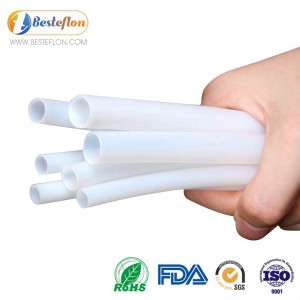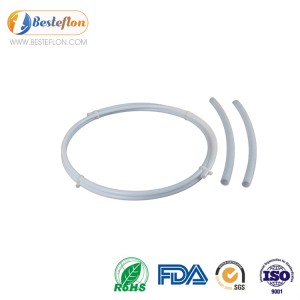Polytetrafluoroethylene (PTFE) is a semi-crystalline fluoropolymer. PTFE is well-known for its application as a non-stick coating for kitchen pots and pans due to its exceptional heat and corrosion resistance.
What Is PTFE?
Let’s begin our exploration of what PTFE actually is. To give it it’s full title, polytetrafluoroethylene is a synthetic polymer consisting of two simple elements; carbon and fluorine. It is derived from tetrafluoroethylene (TFE) and has some unique properties that make it a useful material in a wide range of applications. For example:
Very high melting point: With a melting point of around 327°C, there are very few situations where PTFE would be damaged by heat.
Hydrophobic: It’s resistance to water means it never gets wet, making it useful in cooking, wound dressings and more.
Chemically inert: The majority of solvents and chemicals will not damage PTFE.
Low coefficient of friction: The coefficient of friction of PTFE is one of the lowest of any solid in existence, meaning nothing will stick to it.
High flexural strength: It’s ability to bend and flex, even at low temperatures, means it can be easily applied to a variety of surfaces without losing its integrity.
Processing of PTFE
PTFE can be found in granular, dispersion and fine powder forms. Semi-crystalline PTFE has high melting temperature and melt viscosity, making typical extrusion and injection moulding difficult. PTFE processing is, therefore, more similar to powder processing than that of traditional plastics.
Granular PTFE is produced in a water-based suspension polymerisation reaction. The resulting granular resin is often processed into shape through compression moulding. PTFE dispersion products are produced in a similar manner, with added dispersing agents. Dispersion products can be used for PTFE coatings or they can be processed into a thin film by film casting. PTFE powder is produced in an emulsion polymerisation reaction. The resulting fine powder can be paste extruded into PTFE tapes, PTFE tubing, and wire insulation, or used as an additive to increase corrosion resistance in other polymeric materials.
Top 5 Applications of PTFE
1. Application of anti-corrosion properties
Rubber, glass, metal alloy and other materials fail to meet the harsh conditions of temperature, pressure and chemical media coexistence environment due to their defects in corrosion resistance. However, PTFE has excellent anti-corrosion resistance and thus has become the main corrosion-resistant materials for petroleum, chemical, textile and other industries.
2. Application of low friction properties in load
Oil lubrication is not suitable for friction parts of some equipment, because lubricating grease can be dissolved by solvents and does not work, or products in the pharmaceutical, food, textile and other industrial fields need to avoid staining by lubricants. Consequently, PTFE plastic, whose coefficient of friction is lower than any other known solid material, has become the most ideal material for oil-free lubrication (direct load bearing) of mechanical equipment parts.
3. Application in electrical and electronic
Inherent low loss and small dielectric constant of PTFE material enables itself to be made into enameled wire for micro motors, thermocouples and control devices. PTFE film is the ideal insulation material for manufacturing capacitors, radio insulation liner, insulated cables, motors and transformers, and is also one of the indispensable materials for aerospace and other industrial electronic components.
4. Application in medical medicine
Expanded PTFE is purely inert and very biologically adaptable, so it does not cause rejection by the body, has no physiological side effects on the human body, can be sterilized by any method, and has a multi-microporous structure.
5. Application of anti-adhesive properties
With the lowest surface tension of any solid material, PTFE Teflon does not stick to any substance. Moreover, it has excellent resistance to high and low temperatures. As a result, it has been widely used in anti-adhesive feature of non-stick pans.
If you are in Ptfe Tube,You May Like
The following is a general introduction of the main characteristics of the PTFE tubes:
1. Non-adhesive: It is inert, and almost all substances are not bonded to it.
2. Heat resistance: ferroflurone has excellent heat resistance. General work can be used continuously between 240℃ and 260℃. Short time temperature resistance to 300℃ with a melting point of 327℃.
3. Lubrication: PTFE has a low friction coefficient. The friction coefficient changes when the load slides, but the value is only between 0.04 and 0.15.
4. Weather resistance: no aging, and better non-aging life in plastic.
5. Non-toxic: in the normal environment within 260℃, it has physiological inertia and can be used for medical and food equipment.
Buying the right PTFE tubing is not only about choosing different specifications for different applications. More to choose a reliable manufacturer. Besteflon Fluorine plastic Industry Co., Ltd. specializes in the production of high-quality PTFE hoses and tubes for 20 years. If any questions and needs, please feel free to consult us for more professional advice.
Related Articles
Post time: Mar-15-2024


